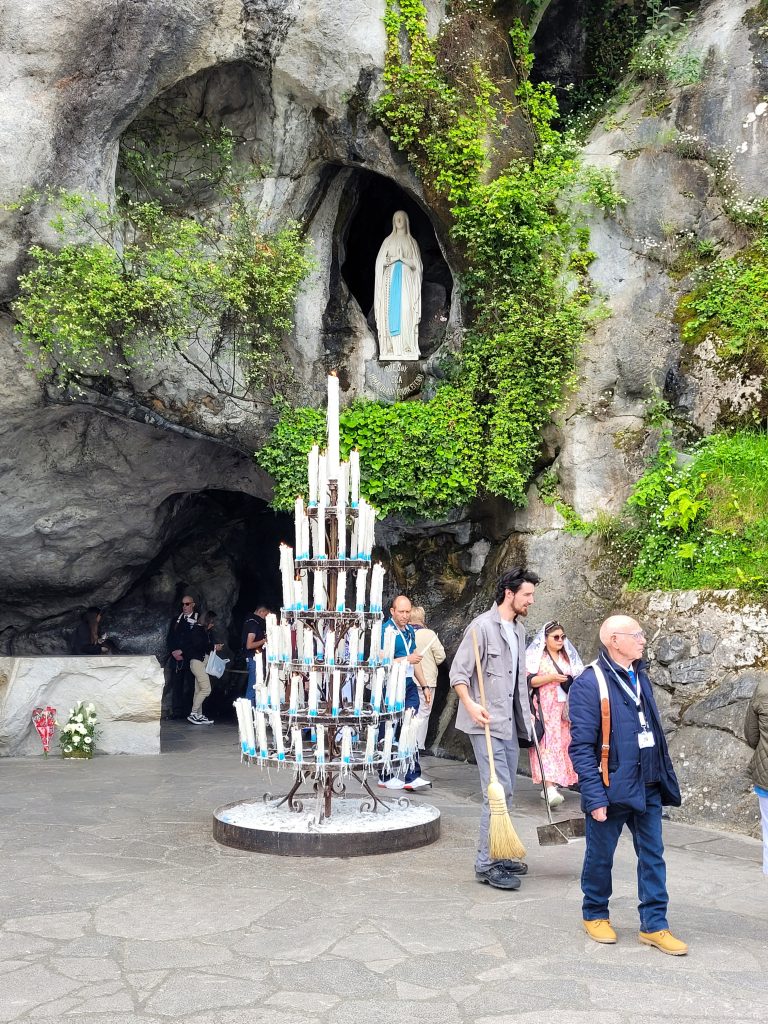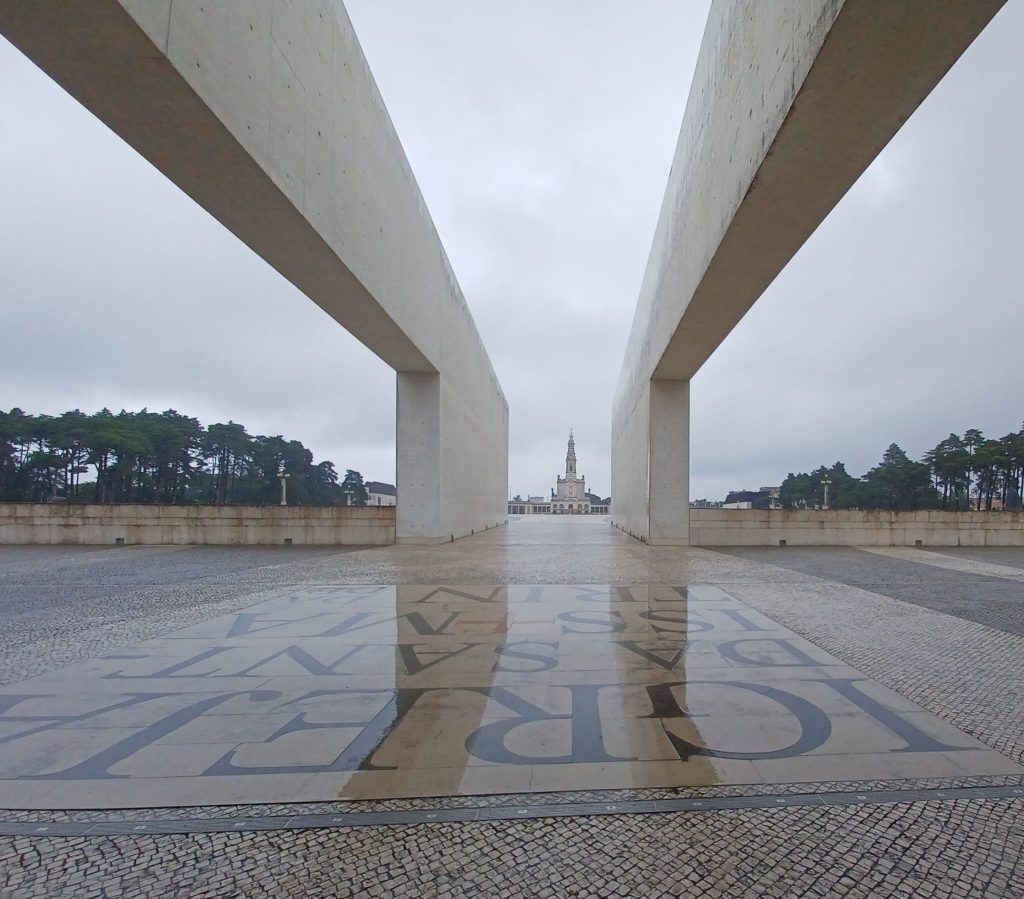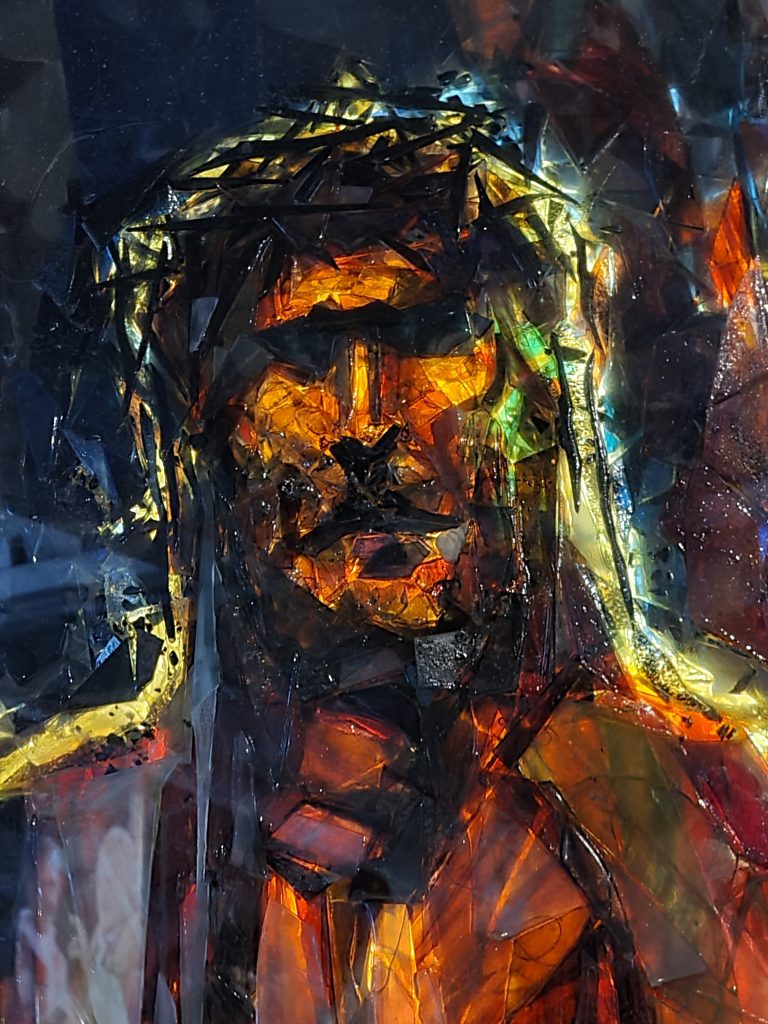We decided to take the opportunity to visit Lourdes as we were passing en route to Portugal. We then found out about Fatima in Portugal which neither of us had ever heard about. Another very important shrine in the Catholic Church.
Millions of people make a pilgrimage to these shrines, both dedicated to Mary, the mother of Jesus.
LOURDES, FRANCE
https://en.wikipedia.org/wiki/Lourdes_apparitions

The Lourdes apparitions are several Marian apparitions reported in 1858 by Bernadette Soubirous, the 14-year-old daughter of a miller, in the town of Lourdes in southern France.
From 11 February to 16 July 1858, she reported 18 apparitions of “a Lady”. Soubirous described the lady as wearing a white veil and a blue girdle; she had a golden rose on each foot and held a rosary of pearls. After initial skepticism from the local clergy, these claims were eventually declared to be worthy of belief by the Catholic Church after a canonical investigation. The apparition is known as Our Lady of Lourdes.
According to Soubirous, her visions occurred at the grotto of Massabielle, just outside Lourdes. On 16 July 1858, Soubirous visited the grotto for the last time and said: “I have never seen her so beautiful before.”[2][page needed] On 18 January 1862, the local bishop declared: “The Virgin Mary did appear indeed to Bernadette Soubirous.”[3] Soubirous was canonized a saint in 1933 by Pope Pius XI. In 1958, Pope Pius XII issued the encyclical Le pèlerinage de Lourdes (“The pilgrimage to Lourdes”) on the 100th anniversary of the apparitions. Pope John Paul II visited Lourdes three times; Pope Benedict XVI visited Lourdes on 15 September 2008 to commemorate the 150th anniversary of the apparitions.
Imagine a large, expanse of common land with wild flowers, bushes, trees the backdrop of an expanse of stone rising from the ground. A place where animals were pastoured and firewood collected. Here to be discovered, played within by children, was a natural, shallow, grotto (the grotto of Massabielle) with an overhang. Down it drips water in certain places. This would have been countryside just outside the town of Lourdes where young teenager Bernadette, lived with her family. Her visions were quickly verified. The spring water from the grotto is believed to possess healing properties . Since 1860 an estimated 200 million people have visited the site. The Roman Catholic church has recognised 69 miraculous healings. The site now supports 3 basilicas, fountains providing Lourdes water. Masses are held all through the day. The underground Basilica, completed in 1958 can accommodate 25,000 worshippers.
FATIMA – PORTUGAL
https://en.wikipedia.org/wiki/Our_Lady_of_F%C3%A1tima

Our Lady of Fátima (Portuguese: Nossa Senhora de Fátima, pronounced [ˈnɔsɐ sɨˈɲɔɾɐ ðɨ ˈfatimɐ]; formally known as Our Lady of the Holy Rosary of Fátima) is a Catholic title of Mary, mother of Jesus, based on the Marian apparitions reported in 1917 by three shepherd children at the Cova da Iria in Fátima, Portugal. The three children were Lúcia dos Santos and her cousins Francisco and Jacinta Marto. José Alves Correia da Silva, Bishop of Leiria, declared the events worthy of belief on 13 October 1930.[3]
Pope Pius XII granted a pontifical decree of canonical coronation via the papal bull Celeberrima solemnia towards the venerated image on 25 April 1946. The designated papal legate, Cardinal Benedetto Aloisi Masella, carried out the coronation on 13 May 1946, now permanently enshrined at the Chapel of the Apparitions of Fátima. The same Roman Pontiff also raised the Sanctuary of Fátima to the status of a minor basilica by the apostolic letter Luce superna on 11 November 1954.
The published memoirs of Sister Lúcia in the 1930s revealed two secrets that she claimed came from the Virgin Mary, while the third secret was to be revealed by the Catholic Church in 1960. The controversial events at Fátima gained fame due partly to elements of the secrets, prophecy and eschatological revelations allegedly related to the Second World War and possibly more global wars in the future, particularly the Virgin’s request for the Consecration of Russia to the Immaculate Heart of Mary.
Imagine three primary age shepherd children receiving an apparition becoming known as Our Lady of Fatima, in a tree, whilst guarding the families’ sheep. The apparition occurred six times, once a month and by the final 70,000 pilgrims joined them at the site. Several huge churches now exist alongside a square half as big again of St Peter’s Square in Rome which will hold a million people. Over 4 million pilgrims visit the town per year.
OUR EXPERIENCE
Lourdes is an enclosed area and for us, walking from our nearby campsite, we had to show an entry card. The place is rather beautiful beside a river and various things were happening either side of the river as we reached the central part. We walked past what were the baths where people queued to interact with the Lourdes water. As we visited in May the crowds were not huge, but still many, many people.
We quickly realised that a group of seated people were those who were sitting in front of the grotto itself. A queue of people were quietly, reverently, walking forward to touch the wall of the grotto with their left hand, wipe a handkerchief over the water on the rockface, acknowledge the statue of Mary, have a picture taken in front of it and then slowly walk through and leave or sit in silence.
In Fatima we walked from the car, in the rain, around to the front of the Basilica which seats thousands into the vast open square, so reminiscent of St Peter’s but even bigger. The whole area of this shrine takes up a quarter of the town. It is not enclosed. There was a covered area open at the back in the square and it seemed a mass was being said there constantly. We were interested to find the original tree where the Lady made herself known, unfortunately so many people wanted a personal relic and that tree is deceased. Another has taken its place!!
We wandered through all these vast expressions of devotion bemused.
- We couldn’t help but be touched by the sincere devotion of many of the people we walked amongst. Some were tourists like us, but so many were here because they needed something that only God could give.
- The devotion to Mary was difficult. We felt a misdirection in their faith because for us the continued focus on Mary is difficult to understand. It appears Mary is as important as Jesus. Could it be because Jesus as expressed in the Catholic Faith has become so transcendent he is difficult to access. Mary as a mother, can seem more available, more empathetic, and more able to understand their everyday lives. This is a Mary who has been elevated to sit in heaven almost as a fourth person of the trinity sometimes. The Mary we understand is human, a mother of many children, a believer in her own son, a person who listened to God and humbly gave birth to His son. Surely this tells us more about God than it does about Mary.
- The images of Jesus are invariably Jesus on a Cross or during the passion week. His ascension is in the stages of the cross, but most of the images are his suffering and death.
- It was difficult to watch the things people felt necessary to do to gain access to God – lighting candles, saying the rosary, touching the grotto and then touching their heads, the head of a child, wiping their faces. One of the most difficult things to watch was women walking on their knees down a stone pathway in Fatima. This was in the rain.
- The hope was palpable – would God heal me, deliver me, do something in my life that nothing else can touch?
- We were struck by the numerous ethnicities, ages, people in wheelchairs pushed by armies of volunteers, various diseases on show and hidden, all wanting an encounter with God.
- And God does seem to meet with people. Maybe not what they wanted or were looking for, but there was thankfulness. In Lourdes, stone plaques declared their thanks in a multitude of languages all over the walls of one of the chuches
- The outstanding Lourdes church building for us was the huge underground basilica which would hold 25,000 people. The Fatima church building was the basilica opposite the main dominating basilica which held 20,000. Breathtaking modern art. It was obvious in all the buildings that no expense had been spared on the buildings, whether 19th century or 20th century.
- The church visibly tried to care for the people with masses always available along with confession in any number of languages.
- We were also very appreciative of the fact that the Church kept the sanctuaries clear of any commercial activity.
We were moved by the sincerity of devotion of the pilgrims, however, our conviction is that the bible speaks of a God who wants to make Himself known wherever we find ourselves.
